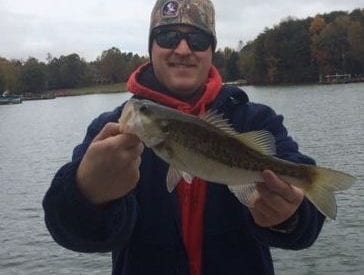
By: Jake Bussolini
Many anglers look at the winter months as a time to bemoan the cold weather and fall back to a couch potato status, locking themselves into some day time television series.
What a mistake these folks are making because winter does not necessarily mean fishing stops all together. Here in the south and more specifically on Lake Norman, it takes some time for the water temperature to drop to the 40 degree level when fish began to slow down their eating habits and become much harder to catch.
I originally moved to this area because Lake Norman provided twelve months of fishing opportunity because of the abundance of the Striped Bass that resided here.
Well, the Striped Bass are all but gone from the lake now because they could not withstand the water temperature and oxygen variations of the late summer months.
Slowly but surely the Stripers are being replaced by Hybrid Stripers, a species that can withstand the lakes temperature variations. For several years now, the State has been successfully stocking Hybrids and from all reports, that species is doing very well and within a few short years, this lake will again provide good year-round angling opportunities. This is not to say that fish cannot be caught on the lake during the colder months, they can, they just need to be fished deeper.
Several years ago when I started writing books about fresh water fishing, I tried to find good data on water temperature variations as a function of water depth. To my surprise, no such data existed as a general guide for anglers so I decided to take a few days to make my own determinations. Using my swimming pool thermometer, I spent hours in different areas of the lake dropping the thermometer to different depths and measuring the water temperature at those depths. My conclusion was that as a general guide, the water temperature change was approximately 2.O degrees for every 10 feet of water depth. This meant that in the colder months the water was warmer at the deeper depths and in the summer months it was colder as the depth increased.
For fishing in the colder winter months, I simply had to change my lure or bait depths to reach water that was at least 50 degrees to find active fish. That meant that on occasion I had to go down 50 or 60 feet to find active fish.
I started this article wanting to discuss things other than fishing that can be done in the winter months, so let’s get on to that. Winter is a great time to re-spool all of your reels with new line. Since I spend a great deal of time on the water, I leave my gear on my boat at all times and because that exposes my line to sunlight and other weather conditions, I normally re-spool four time a year. For most part-time anglers it is not necessary to re-spool that often and a cold winter day is a good time to re-spool. This is also a great time to clean and oil your reels before you apply the new line.
I’m often asked about the best line to use on Lake Norman. I am not a “brand guy” so I do not favor any specific brand of line because I have found that any of the four or five popular brands are all good. Buy what you can afford and it will probably serve you well. I normally use monofilament line for this lake and a line test of between 7 and 10 pounds will land any fish that resides here. For those who fish specifically for catfish, you will have to go to a much heavier line test. Don’t be afraid to fill your reel spool all the way which means spool it until the line is about the thickness of a nickel from the top of the spool. As the months progress you will be making pull tests before every fishing trip and at times you will be taking off 10 or 15 feet of line that may have weakened.
How about rod maintenance? There really isn’t much that you can do to keep your rods in good condition. Most important is to inspect each of the eyes on the rod insuring that there are no wear points on the inside loops. The most important eye is the one at the tip of the rod since this eye gets the most abuse by the line. Make sure that this eye has no nicks or scratches on the inside loop. The tip eye is the easiest to replace if rough spots are found.
One of the most neglected items in your equipment box is the actual fishing hook. Believe it or not hooks get dull. If you are using terminal tackle that includes a hook, throw the old one away in the winter and tie on a new hook. Also check your favorite lure of jig to see that the hooks are not bent or damaged. It takes some time and care but the hooks on your favorite lures and jigs should be changed every year as a minimum. You would be surprised how many fish are lost due to dull or damaged hooks.
If you run out of things to fix in your fishing box during the winter months and you don’t want to weather the cold, go to my book store at www.booksbyjake.com and buy one of my poplar fishing books. You may be surprised what you will learn.
By Jake Bussolini
